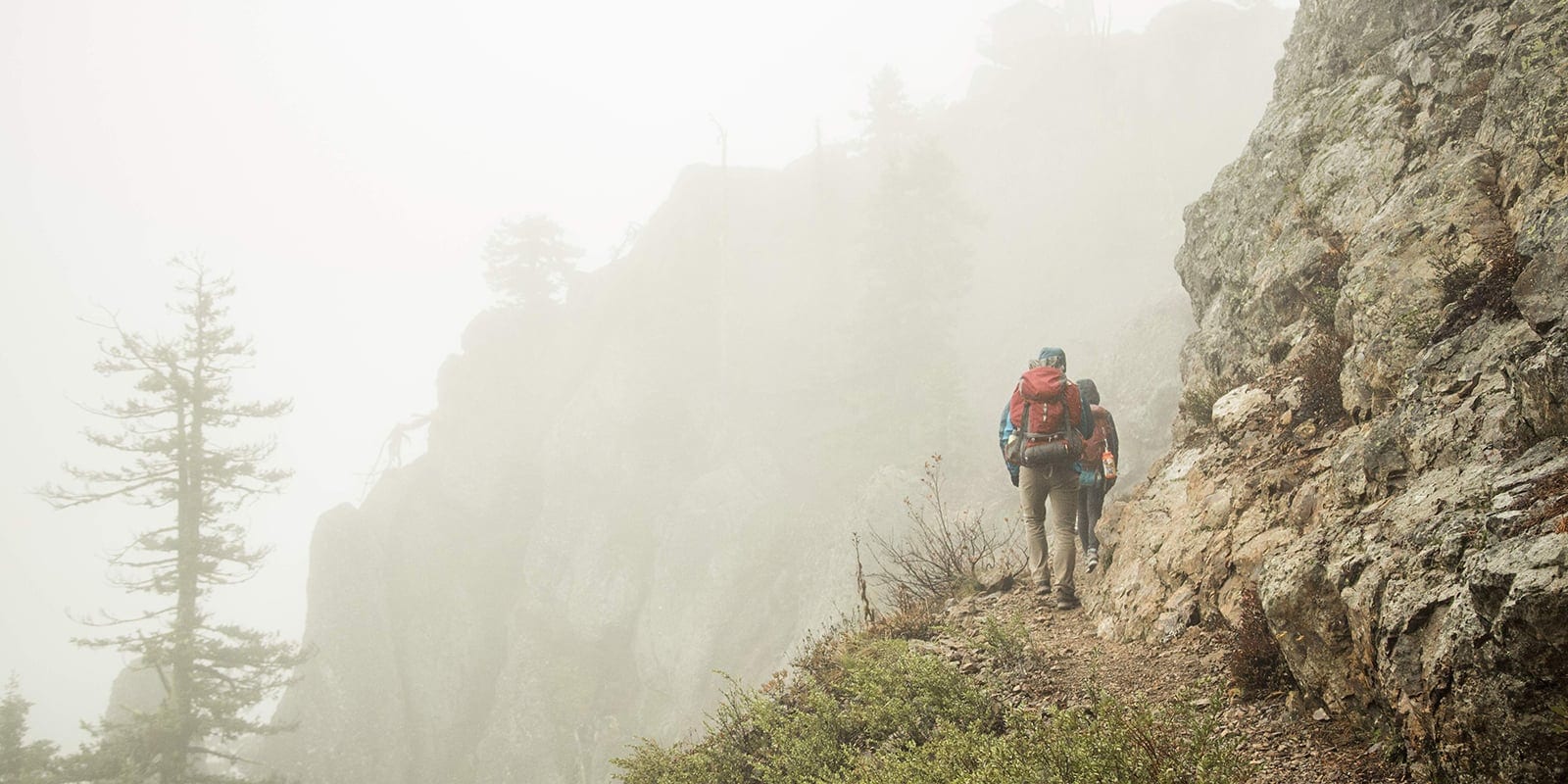Into each life, some rain must fall. If you're a backpacker with the right mindset, this can make the woods a more beautiful place: crisper, cleaner and calmer. Heavy rainfall can also present some special challenges, though, if you're not prepared.
For some tips on how to thrive on a wet-weather hike, we turned to REI's Laura Evenson, whose 2013 Appalachian Trail thru-hike featured 27 straight days of rain. Her advice on precip preparation covers:
- Gearing up
- Trail hazards
- Campsite tactics
- Drying out
Gearing Up
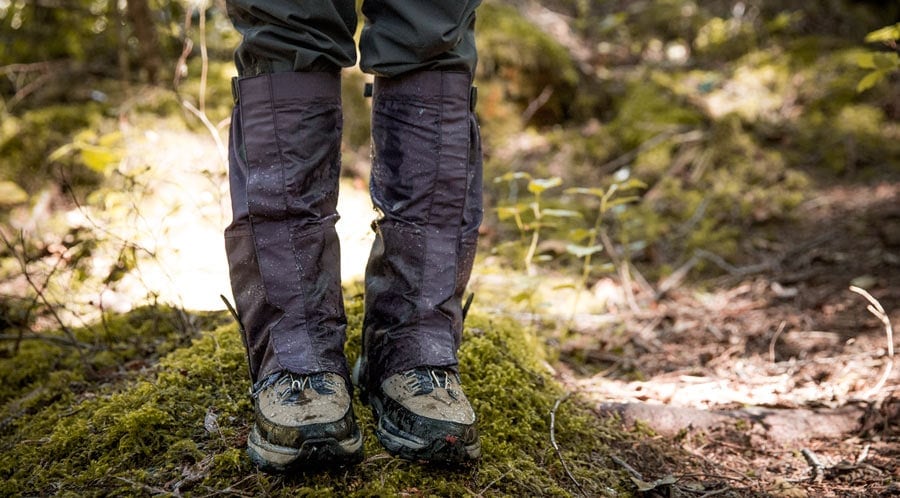
When rain is a distinct possibility, it's wise to adjust your gear list. Take a closer look at your clothing, including outerwear and footwear. You also want to assess the rain-readiness of both your pack and tent.
Clothing Strategies
- Absolutely no cotton. This is especially true in next-to-skin layers because cotton doesn't wick sweat away from your skin and it takes a long time to dry. In soggy conditions, that means you'll get chilled and become more susceptible to hypothermia. Go with wool, nylon or polyester clothing instead.
- Evaluate your rainwear. A soft shell alone won't be enough. You need a hard shell for full waterproof protection. Because rainwear brands update technology often, an upgrade is worth considering. First, though, read Rainwear: How to Choose.
- Renew your rainwear's Durable Water Repellent (DWR). If you think your current rainwear needs replacing, first check to see if raindrops bead up and roll off. If not, there's a good chance that renewing its DWR coating can restore performance.
- Evaluate your footwear. Waterproof options work well in colder conditions, keeping your feet warmer and drier initially; nonwaterproof mesh footwear works well in milder conditions, draining and drying more quickly if you land in a puddle or creek. With either option you need deep lug soles to deal with mud and superior traction to deal with slippery rocks and logs.
- Pack more substantial camp shoes. You want camp shoes that will be secure underfoot, so you can wear them around a muddy camp or to wade across a high creek. Then you can change to your still-dry trail boots on the other side.
- Go with gaiters or rain pants. If you forgo rain pants in favor of greater breathability, then you should pack gaiters to shield your socks and the tops of your footwear from rain. You'll also need an extra pair of dry pants.
- Take a rain hat. In addition to avoiding cotton, look at hats with a wide brim or long bill to keep your face (and glasses) drier.
- Bolster your dry clothing stash. Extra clothing is already one of the Ten Essentials. Never skimp on the amount of extra clothes you pack when rain is in the forecast. Bringing extra clothing that you only use for sleeping helps ensure you'll always be dry and warm in your sleeping bag.
- Bring blister supplies. Moisture makes feet more susceptible to blisters. So, in addition to making sure you have multiple pairs of wool or synthetic hiking socks, you should double-check the blister-treatment items in your first-aid kit.
Extra Pack Protection
Though many packs are made of waterproof material, their seams aren't sealed. In addition, all of the places that make gear accessible to you—like a top lid or an open stash pocket—also make it accessible to precipitation. Even zippers that are water resistant or covered with a flap can let water sneak in eventually.
Added protection options for your pack include the following:
- Pack raincover. Some packs come with one, or you can buy a cover sized to fit your pack. If you're willing to listen to it flapping in the wind, you can also adapt a trash bag by cutting slits for shoulder straps.
- Pack liner(s). You can use a trash-compactor bag, buy a special pack liner or use several smaller plastic bags for key gear. Your main pack and exterior pockets can get soaked eventually, making your load heavier. Your essential gear, though, will remain dry.
- Lightweight dry sacks. These can be used like the smaller plastic bags noted above. In addition, even if you have a pack cover or liner, you should use dry bags for your most vulnerable gear. Using one as a sleeping-bag stuff sack is smart, especially if you have a down bag. Storing food in a dry bag not only protects it from moisture, it also provides a handy top handle when you hang it up to prevent bears and rodents from getting to it.
- Waterproof gadget cases. You can put things like your cellphone or expensive digital camera in a plastic bag or dry bag. Getting a specially designed waterproof case, though, will provide even better protection.
Trail Hazards
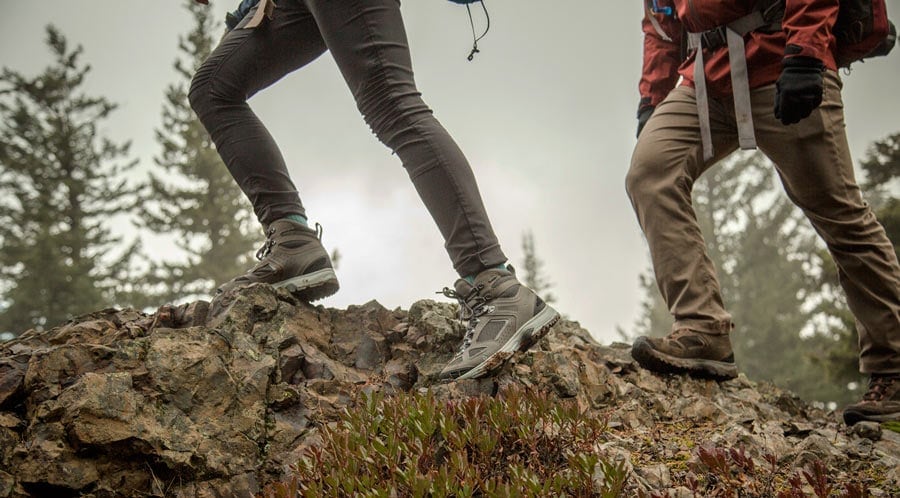
A significant storm system can create added dangers and health concerns. If you're on the lookout for them, you can take steps to avoid unwanted complications.
- Slippery surfaces. Even if your footwear has great traction, you still need to tread extra carefully on muddy slopes, slimy rocks and rain-slickened logs.
- Trekking poles are a huge help, and can be your best friend on a rainy hike.
- Swollen creeks. Water will be running faster and higher, requiring extra care on every crossing. Unbuckle your hipbelt before you cross, so you can easily get free of your pack if you slip and fall into a fast-moving current.
- Flash floods. If you'll be in canyon country, check the forecasts ahead of time and keep an eye out for quickly accessible higher ground.
- Hypothermia. Learn to recognize the early symptoms, which include shivering and confusion, because it can creep up on you in cool, rainy weather. Wear wool or synthetic clothes because they continue to insulate even when damp. Change into dry clothing when you are no longer moving.
- Dehydration. It's easy to forget to hydrate when you're in the middle of a downpour. Be sure to drink and eat even though it may be inconvenient; if rain discourages stops, drink and snack while you're hiking.
Campsite Tactics
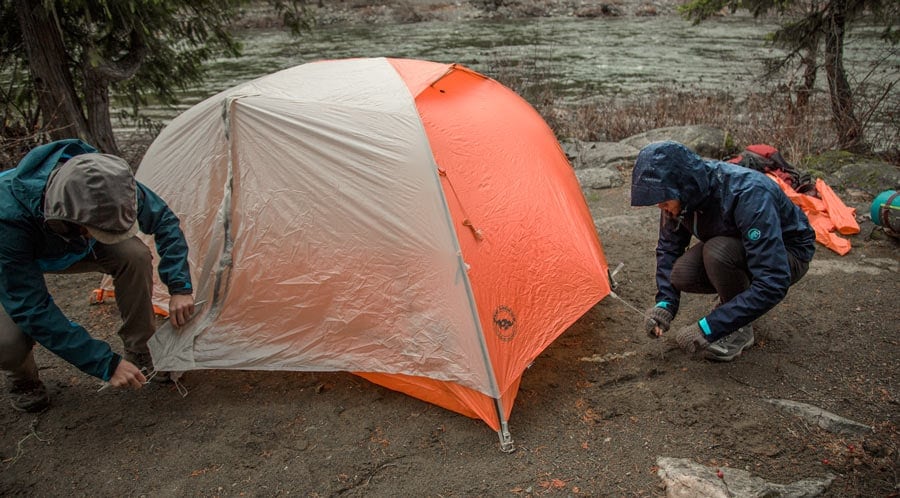
Site Selection
Most of the following tips are from our How to Set Up a Tent article:
- Seek higher, drier ground. You'll have less moisture in the air to form condensation inside the tent as temperatures drop.
- Look for sites under trees. They create a warmer, more protected microclimate that will produce lower levels of condensation.
- Avoid sites under damaged limbs or trees. A strong gust can bring them down on top of you.
- Avoid camping in low areas between high areas. Rain can channel through and pool when a storm blows in.
- Orient doors away from the wind. You'll prevent rain from blowing in.
Pitching Tips
When the rain is coming down sideways, speed counts. Beyond general pitching tips, here are some rainy-day strategies for ensuring that your tent is well set up:
- Practice at home. It lets you double-check that all the parts are there and helps you develop into a quick-pitch artist.
- Use a footprint. As the ground gets more and more sodden, you'll be glad you took the time to lay down this extra layer of protection.
- Be wary of the fly-first pitch. Though some tents offer this option, it often takes longer than the standard tent-first pitch.
- Recruit rainfly holders. You'll get less rainfall on the main tent if hiking pals or people camping nearby hold the fly over your tent while you pitch it.
- Tighten it up and guy it out. Though it's tempting to dive in as soon as the tent is minimally in place, your rainfly needs to be rock-solid first.
- Become a vent master. If your fly has vents, use them to prevent condensation buildup. Open them wide and check them often to be sure they aren't letting in rain. Open vents in opposing pairs, rather than all at once, in order to create flow-through ventilation.
Drying Out
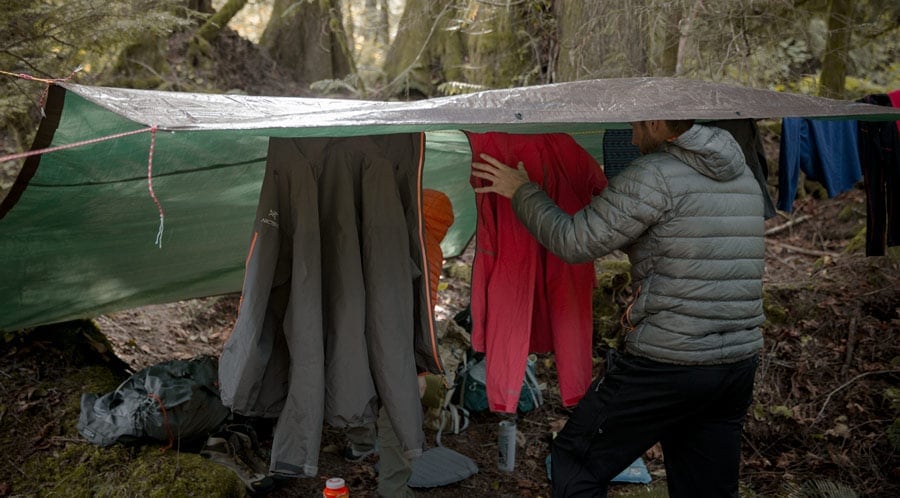
When the weather gods conspire to hit you with seemingly endless days of unrelenting rain, it's important to make the most of each and every opportunity to dry yourself out.
- Preserve a dry set of camp clothes. Keep them in a dry bag and don't open it until you're inside your tent. Dry clothes will do wonders for your comfort level and your mental health.
- Switch to dry clothes during the day, too. A midday change to dry pants or socks or base layers bolsters your spirit and deters hypothermia.
- Seize weather windows. Dry gear is more important than making time. Halt immediately, set out your wet stuff and let the sun work its magic. (Utility cord can double as a clothesline.) Laying over an extra day to fully dry out after a storm breaks is also wise, especially if more wet stuff is on the way.
- Dry out gear at home. It's essential that you completely dry out gear after every trip. Failure to do so causes mildew and mold to grow, ultimately ruining your gear. Always make sure your gear is completely dry before you put it away.
